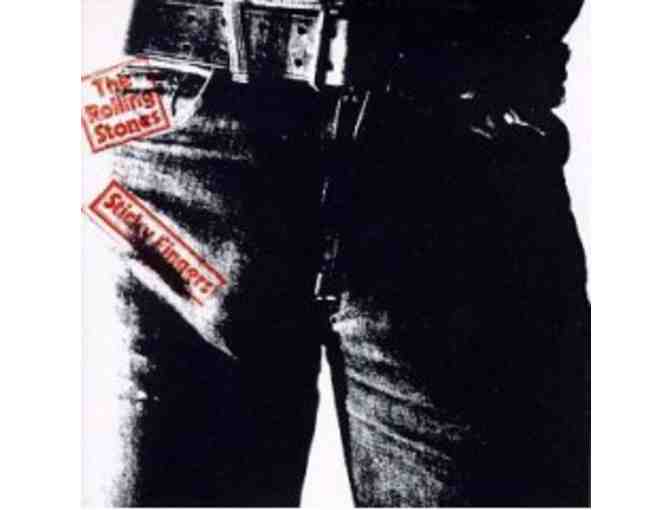Collectibles
Sticky Fingers Album Cover in frame (12 X 12") - No LP included
- Item Number
- 235
- Estimated Value
- 25 USD
- Sold
- 26 USD to khf89e417
- Number of Bids
- 5 - Bid History
Item Description
Sticky Fingers is the ninth British and eleventh American studio album by the English rock band The Rolling Stones, released in April 1971. It is the band's first album of the decade and the first release on the band's new label Rolling Stones Records, after having been contracted since 1963 with Decca Records in the UK and London Records in the US. It is also Mick Taylor's first full-length appearance on a Rolling Stones album and the first Rolling Stones album not to feature any contributions from guitarist and founder Brian Jones.
Sticky Fingers is considered one of the Rolling Stones' best albums. It achieved triple platinum certification in the US, with songs such as the chart-topping "Brown Sugar," the country ballad "Dead Flowers", "Wild Horses," "Can't You Hear Me Knocking," and "Moonlight Mile".
History
With the end of their Decca/London association at hand, The Rolling Stones were finally free to release their albums (cover art and all) as they pleased. However, their departing manager Allen Klein dealt the group a major blow when they discovered that they had inadvertently signed over their entire 1960s copyrights to Klein and his company ABKCO, which is how all of their material from 1963's "Come On" to Get Yer Ya-Ya's Out! The Rolling Stones in Concert has since been released solely by ABKCO Records. The band would remain incensed with Klein for decades for that act.
When Decca informed The Rolling Stones that they were owed one more single, they cheekily submitted a track called "Cocksucker Blues", which was guaranteed to be refused. Instead, Decca released the two-year-old Beggars Banquet track "Street Fighting Man" while Klein retained dual copyright ownership in conjunction with The Rolling Stones of "Brown Sugar" and "Wild Horses."
Recording
Although sessions for Sticky Fingers began in earnest in March 1970, The Rolling Stones had been recording at Muscle Shoals Sound Studio in Alabama in December 1969. "Sister Morphine," cut during Let It Bleed's sessions earlier in March of that year, had been held over from this release. Much of the recording for Sticky Fingers was made with The Rolling Stones' mobile studio unit in Stargroves during the summer and autumn of 1970. Early versions of songs that would eventually appear on Exile on Main St. were also rehearsed during these sessions.
Artwork - Standard version
The Rolling Stones posing in an ad with covers of Sticky Fingers, with the original artwork, in 1971, from left to right: Charlie Watts, Mick Taylor, Bill Wyman, Keith Richards, and Mick Jagger
The album's artwork emphasises the suggestive innuendo of the Sticky Fingers title, showing a close-up of a jeans-clad male crotch with the visible outline of a large penis; the cover of the original (vinyl LP) release featured a working zipper and perforations around the belt buckle that opened to reveal a sub-cover image of cotton briefs. The vinyl release displayed the band's name and album title along the image of the belt; behind the zipper the white briefs were seemingly rubber stamped in gold with the stylized name of American pop artist Andy Warhol, below which read "THIS PHOTOGRAPH MAY NOT BE—ETC." While the artwork was conceived by Warhol, photography was by Billy Name and design was by Craig Braun. Braun and his team had other ideas, such as wrapping the album in rolling paper - a concept later used by Cheech & Chong in Big Bambu - but Jagger was enthused by Warhol's cover with a zipper. Execution was then handled as Warhol sent Braun Polaroid pictures of a model in tight jeans.
The cover photo of a male model's crotch clad in tight blue jeans was assumed by many fans to be an image of Mick Jagger, but the people actually involved at the time of the photo shoot claim that Warhol had several different men photographed (Jagger was not among them) and never revealed which shots he used. Among the candidates, Jed Johnson, Warhol's lover at the time, denied it was his likeness, although his twin brother Jay is a possibility. Those closest to the shoot, and subsequent design, name Factory artist and designer Corey Tippin as the likeliest candidate. Warhol "superstar" Joe Dallesandro claims to have been the model.
After retailers complained that the zipper was causing damage to the vinyl (from stacked shipments of the record), the zipper was "unzipped" slightly to the middle of the record, where damage would be minimised. (Wikipedia)
Item Special Note
Winner must pick up at our main studios during regular business hours, 220 S 4th Avenue, Tucson AZ 85701, or it can be mailed for $7.20.
KXCI 91.3FM Community Radio stores data...
Your support matters, so KXCI 91.3FM Community Radio would like to use your information to keep in touch about things that may matter to you. If you choose to hear from KXCI 91.3FM Community Radio, we may contact you in the future about our ongoing efforts.
Your privacy is important to us, so KXCI 91.3FM Community Radio will keep your personal data secure and KXCI 91.3FM Community Radio will not use it for marketing communications which you have not agreed to receive. At any time, you may withdraw consent by emailing Privacy@frontstream.com or by contacting our Privacy Officer. Please see our Privacy Policy found here PrivacyPolicy.

